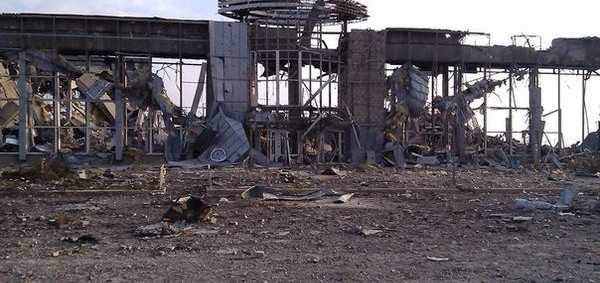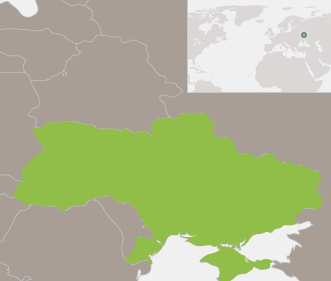Paul Biddle served as a UK secondee to the OSCE Special Monitoring Mission in Ukraine, Luhansk (Lugansk) field office from April 2014-March 2015. He was over various times security, military and police focal point, operations officer, patrol leader and patrol hub leader. In this blog post, he shares his analysis and experience of the situation in Ukraine.
Early access, the Luhansk People’s Republic and the separation line
I joined the mission in April 2014 following the approval of the expansion of the OSCE Special Monitoring Mission. Three days after being seconded, I flew to Kiev for pre-deployment before setting off by car to Luhansk city. Initially, very little was explained to us regarding the political and security situation other than it was quickly deteriorating. The 800 km journey was only hindered by the fact that the OSCE escorting convoy was held at the separation line between the Luhansk People’s Republic (LPR) and the de facto government forces for several hours.
Having negotiated our passage through the separation line, it was clear that very little stood between both forces; the poorly constructed LPR check points made from tyres, and the militia with poorly maintained weapons could very easily have been overpowered. However, the Ukrainian military were clearly reluctant to undertake any military actions against their own people, and the political transition ongoing with a yet-to-be determined democratically elected government was also a factor that limited the possibilities of official, state-sanctioned operations.
This gave the LPR an opportunity to garner greater support from the people and from Russia and obtain much needed support, equipment as well as volunteer manpower. It also provided other separatist groups such as the Cossacks an opportunity to carve out small but important “empires” within the Luhansk Oblast. (Note: At this time, we saw no sign of regular Russian Federation troops or equipment.)
This inertia from the Ukrainian government in tackling the separatists’ groups in Eastern Ukraine gave those on the political right - “Pravyi Sektor” – added motivation and incentives to form paramilitary “Battalions” to organize and fight against those groups.
What is clear now is that had a democratically elected government been in place in April and acted decisively (politically and within the rule of law) much could have been achieved in re-asserting government control.
Of ski masks, a deteriorating security situation and an hostage situation
In May 2014, our team realized that the security situation in Luhansk was deteriorating. Our hotel had been taken over by armed men in ski masks, heavily armed with the latest Russian-made assault rifles, as well as our interpreters confirming their accents as “Moscow Russian”. We saw for the first time LPR military patrols in the city, and the makeshift check points were being reinforced with concrete structures.
This deterioration culminated in late May when two OSCE Special Monitoring Mission (OSCE SMM) patrols - one from Donetsk and one from our team in Luhansk – were taken hostage by one of the Cossack commanders. Given this hostage situation as well as the start of direct military action by Ukrainian government forces, it was decided to exfiltrate the team out of Luhansk city to Kharkiv city by train and by car. On arriving in Kharkiv, several members of the mission decided to leave the Luhansk team. A new member who had just arrived was told by one of the interpreters that “all the sane people just left” (in hindsight, I agree!). I nevertheless decided, as well as a few others, to stay and work with the Ukrainian military on the Luhansk contact line.
It is interesting to note that, apart from a single visit from one of the OSCE SMM Deputy Chief monitors, no senior international politician tried to visit Luhansk city to assess the situation and discuss a peaceful resolution during the year I was there.
Monitoring the conflict and its impact on civilians
The team which was initially based in Kharkiv moved to Kup’yans’k then to Starobil’s'k and lastly to Severodonetsk with the aim of monitoring the impact of the conflict on the local population and to monitor the use of extra judicial detention and human rights issues as well as being a visible presence on the front line.
In June 2014, while based in Starobil’s'k, I took the opportunity to take a small team to enter Luhansk city through the “Road of life” (Доро́га жи́зни, doroga zhizni), a semi-secret cross country route, named after the ice road used by the Russians to feed Leningrad during the siege 1941-44 which IDPs used to escape and enter the LPR without going through the check points. During this visit we witnessed the shelling of the city and the clear deprivations the civilian population was undergoing. We also had the opportunity to meet with the senior leadership of the Luhanks People’s Republic (LPR). The LPR leadership at that time expressed a willingness to discuss peace with their counterparts in the Ukrainian government and even though this was reported nothing came of it.
From July to September 2014, we witnessed the battles in and around Shchastya and route 21 and the defeat of the Ukrainian army at Metalist and at Luhansk Airport as well as the shooting down of Malaysia Airlines Flight MH17 and numerous other incidents and clashes
The defeat at Metalist brought about the consolidation of the contact line using the Severodonetsk River and the T1303 route to the west of Luhansk city and with it the move of the OSCE team to Severodonetsk city.
Minsk I and II Protocols and the consolidation of the Luhansk People’s Republic
In July 2014, I had the opportunity to visit Luhansk city to set up communications with the LPR and the international interlocutors as part of the development of the Minsk I Protocol which was agreed to in September 2014.
Our work to monitor and report the Minsk I Protocol was particularly harrowing given that our visits to the Ukrainian frontline checkpoints and units who were under continually fire provided the only short break in the conflict; as soon as we left, we could hear the shelling starting again..
One particular Ukrainian check point “22” on the route T1303 west of Luhansk city was surrounded for over a week without food or water while we tried unsuccessfully at check point 21 to negotiate a ceasefire; the check point was eventually lost to the separatists.
The collapse of Minsk I and the signing of Minsk II in February 2015 saw my team move to Luhansk city to develop a permanent base within the LPR and with it the opportunity to observe first-hand the effects of the conflict on the civilian population within the LPR occupied area as well as those areas allied but not under LPR control. It was also clear that the Russian Federation (RF) had all but taken control of the LPR political and military machine, and RF soldiers and equipment were seen all around the city.
The team monitored LPR hospitals, schools, banks, prisons and mental facilities and freely reported the conditions and in some cases negotiated access to international aid.
One particular place was the regional hospital at Slovyanoserbsk which was on the LPR/Ukrainian contact line. It had been abandoned by the staff apart from six untrained women due to constant shelling. We were the first people to visit and the conditions were horrendous with dead and living lying side by side. Within 24 hours of our visit, we had arranged for Médecins Sans Frontières (MSF) to deliver lifesaving aid.
It was interesting to note that at that time there were no international humanitarian organizations within the LPR. It is also worth noting that our presence in Luhansk city provided the security for international relief organizations to open offices – these organizations however have been asked to leave the LPR in September 2015 .
Our move to Luhansk city gave us the opportunity to reach out to other areas not under the direct control of LPR, this proved to be difficult as permissions had to be obtained days in advance and escorts provided to ensure we only went to areas “approved” by those controlling these areas. However this still gave us a good opportunity to witness the devastation of the Ukrainian artillery on towns and villages in the separatist areas and witness the harsh living conditions of those who stayed.
Finally, in March 2015 I decided to leave the mission at the end of its mandate and handed over the patrol hub to a very able colleague and spent the last few weeks developing operational protocols for the Dnipropetrovsk team who was going to monitor the movement of heavy weapons from the Donetsk People’s republic (DPR) contact line.
Paul Biddle is a Security Governance Group Senior associate who has over over 40 years experience in security and justice related projects and missions, in such diverse places as Papua New Guinea, Afghanistan and Moldova and missions involving counter-terrorism, counter narcotics and countering radicalization and violent extremism. Paul is currently assisting the United Arab Emirates (UAE) police with Crisis and Disaster management training.
Tags: Ukraine






 Visit the Centre for
Visit the Centre for